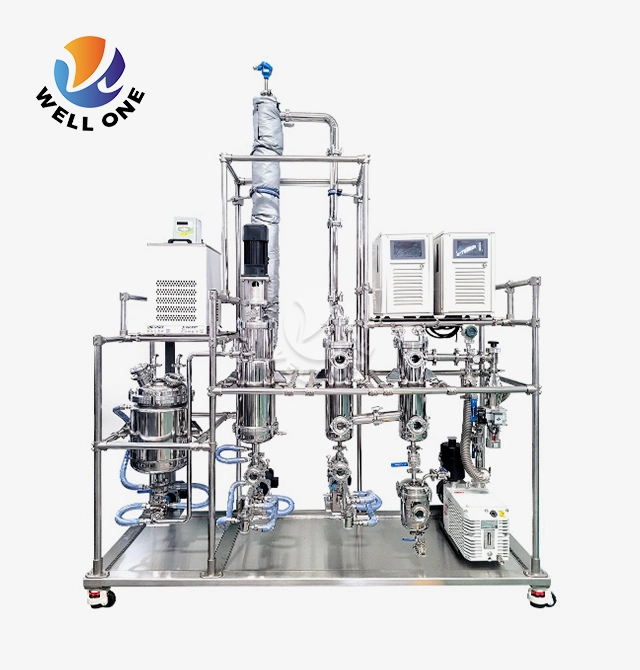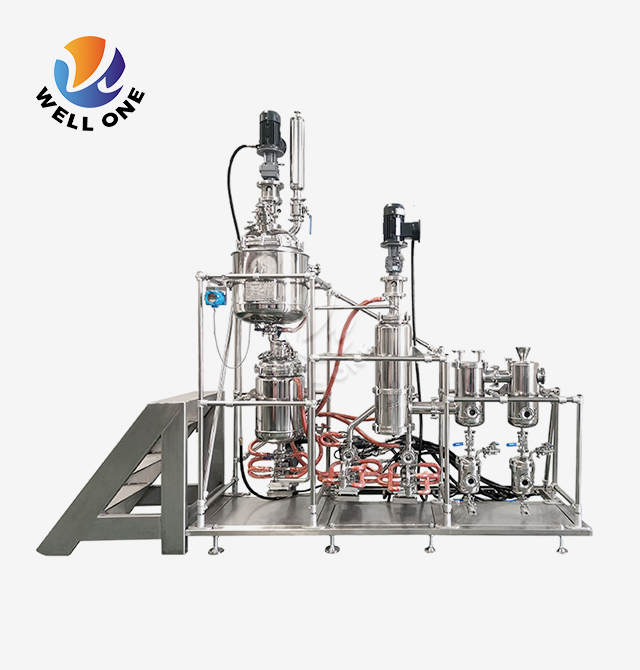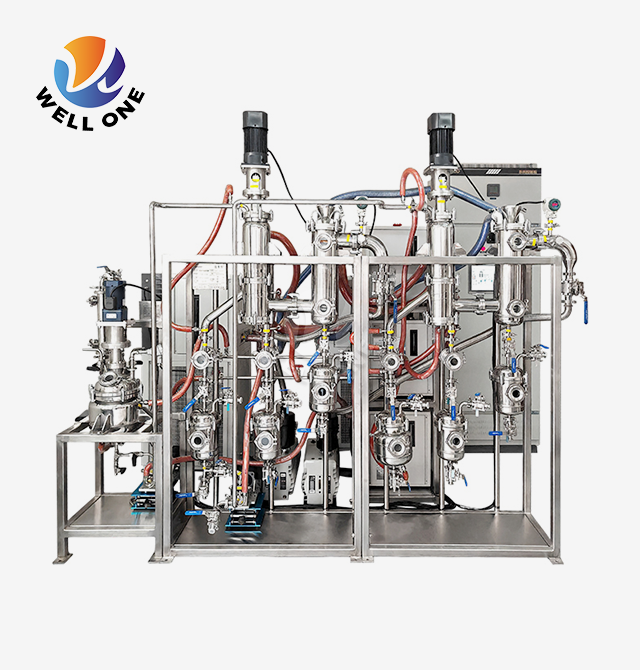Molecular Distillation - How it Works?
Struggling to purify heat-sensitive compounds without degradation or quality loss? Laboratory Molecular Distillation offers the solution you need for separating delicate materials under ultra-high vacuum conditions while preserving their molecular integrity and functional properties.
Understanding Laboratory Molecular Distillation Technology
Laboratory Molecular Distillation represents a revolutionary separation technique that operates fundamentally differently from conventional distillation methods. Unlike traditional distillation that relies on boiling point differences at atmospheric or reduced pressure, Laboratory Molecular Distillation exploits the mean free path of molecules under extreme vacuum conditions typically below 0.001 mbar. This process occurs when the distance between the evaporating surface and condensing surface is shorter than the mean free path of the vapor molecules, allowing direct molecular transport without intermolecular collisions. The technology proves invaluable for thermally unstable compounds that would decompose at temperatures required for conventional distillation, making it essential for pharmaceutical APIs, natural extracts, and specialty chemicals where product integrity cannot be compromised.
The Scientific Principle Behind Molecular Separation
The fundamental mechanism of Laboratory Molecular Distillation relies on the kinetic theory of gases and molecular mean free path calculations. Under ultra-high vacuum conditions ranging from 0.1 to 0.001 Pa, molecules evaporate from a heated surface and travel in straight lines without collision until reaching the condenser positioned just millimeters away. The separation efficiency depends on the difference in volatility between components, which correlates with molecular weight and vapor pressure. Lighter molecules with higher vapor pressures evaporate more readily and travel faster to the condenser, while heavier molecules with lower vapor pressures remain in the residue. This physical separation occurs at temperatures 50-100°C lower than conventional distillation, preventing thermal decomposition of sensitive compounds. The short residence time, typically 1-5 seconds on the heated surface, combined with 316 stainless steel construction ensures minimal thermal stress and maximum product recovery rates exceeding 95% for target compounds.
Key Components of Laboratory Molecular Distillation Systems
Modern Laboratory Molecular Distillation equipment comprises several critical components working synergistically to achieve optimal separation performance. The evaporator features a cylindrical heated surface constructed from corrosion-resistant 316 stainless steel with precise temperature control between 50-300°C via jacketed heating systems. A wiper mechanism, typically rotating at 100-400 RPM, continuously spreads the feed material into a thin film of 0.05-0.5mm thickness across the heated surface, maximizing evaporation surface area and minimizing residence time. The internal condenser, positioned concentrically within the evaporator at a distance of 10-50mm, operates at temperatures 40-80°C below the evaporator to ensure efficient vapor condensation. Advanced vacuum systems incorporating diffusion pumps or turbomolecular pumps maintain operational pressures down to 0.001 mbar, while ABB control systems provide precise parameter monitoring and automated operation. Multi-stage configurations, including single stage, dual stage, and three stage designs, enable sequential purification with each stage targeting specific components, achieving purities exceeding 98% for complex mixtures.
Operating Parameters and Process Optimization
Temperature and Vacuum Control in Laboratory Molecular Distillation
Precise control of temperature and vacuum pressure represents the cornerstone of successful Laboratory Molecular Distillation operations. The evaporator temperature must be carefully optimized based on the vapor pressure characteristics of target compounds, typically operating 20-50°C below their thermal decomposition temperatures. For heat-sensitive materials like omega-3 fatty acids or CBD isolates, evaporator temperatures between 80-120°C combined with vacuum levels below 0.01 mbar prevent oxidation and degradation. The condenser temperature differential, maintained at 40-80°C below the evaporator, ensures complete vapor condensation while preventing reflux of lighter fractions. Modern systems equipped with ABB PLC controls enable real-time monitoring with accuracy of ±0.1% and automated adjustments responding to feed composition variations. Vacuum stability proves critical, as fluctuations above 0.005 mbar can compromise separation efficiency by allowing intermolecular collisions. Advanced sealing systems using PTFE gaskets and metal O-rings maintain consistent vacuum levels throughout extended production runs, while integrated degassing systems remove dissolved gases from feed materials to prevent foaming and ensure stable film formation on the heated surface.
Feed Rate and Film Thickness Management
Optimizing feed rate and film thickness directly impacts separation efficiency and product throughput in Laboratory Molecular Distillation systems. The volumetric feed rate, typically ranging from 0.1 to 5 liters per hour depending on system size, must be balanced against wiper rotation speed to maintain uniform film distribution. Too high feed rates create thick films exceeding 0.5mm that increase residence time and reduce evaporation efficiency, while excessively low rates underutilize equipment capacity and increase unit production costs. The wiper system, constructed from flexible PTFE or metal blades, continuously redistributes material across the heated surface, ensuring consistent film thickness of 0.05-0.3mm optimal for molecular transport. For viscous materials like epoxy resins or vegetable oils, preheating the feed to 40-60°C reduces viscosity and improves film formation. Multi-pass configurations enable reprocessing of residue fractions to maximize recovery of target compounds, particularly valuable for high-value pharmaceutical ingredients where even 2-3% yield improvements justify additional processing costs. Real-time viscosity monitoring coupled with automated feed rate adjustments maintains optimal operating conditions across varying feed compositions encountered in batch processing operations.
Industrial Applications of Laboratory Molecular Distillation
Pharmaceutical and Nutraceutical Purification
Laboratory Molecular Distillation has become indispensable for pharmaceutical manufacturing, particularly for purifying active pharmaceutical ingredients (APIs) that exhibit thermal sensitivity or require ultra-high purity standards. The technology enables concentration of polyethylene glycol (PEG) derivatives achieving narrow molecular weight distributions with dispersity indices below 1.05, critical for controlled drug delivery applications. Squalene purification from plant sources reaches 98% purity through multi-stage molecular distillation, removing fatty acid impurities while preserving antioxidant properties essential for pharmaceutical formulations. The GMP-compliant designs incorporating CIP/SIP capabilities, 316 stainless steel construction, and validation documentation support regulatory compliance for FDA and European Medicines Agency submissions. For nutraceutical applications, the technology excels at concentrating omega-3 fatty acids from fish oil, increasing EPA and DHA content from 30% to 80% while removing oxidized fractions and improving organoleptic properties. Recovery rates reaching 70% compared to 16% for conventional methods dramatically improve process economics and sustainability. The gentle separation conditions preserve bioactive compounds including vitamins, tocopherols, and phytosterols that would decompose under conventional distillation temperatures, maintaining therapeutic efficacy and extending product shelf life.
Essential Oils and Natural Extract Processing
The essential oil and botanical extract industries rely heavily on Laboratory Molecular Distillation for producing premium-grade products with exceptional purity and aroma profiles. Rose essential oil purification exemplifies the technology's capabilities, where supercritical CO2 crude extracts containing waxes, pigments, and low-molecular-weight artifacts undergo molecular distillation at 90-110°C under 0.005 mbar vacuum. The process removes unwanted components while preserving delicate aromatic molecules including phenylethyl alcohol, citronellol, and geraniol that define rose oil's characteristic fragrance. Final products achieve purities exceeding 95% with residual solvent levels below 10 ppm, meeting international standards for cosmetic and aromatherapy applications. CBD isolate production from cannabis extracts demonstrates the technology's precision, separating cannabidiol from THC, CBN, and other cannabinoids with purities reaching 99.8% while preventing decarboxylation and oxidation. The short residence time and low operating temperatures preserve terpene profiles responsible for entourage effects valued in medical cannabis applications. Tea tree oil, lavender oil, and citrus essential oils benefit similarly from molecular distillation, achieving standardized compositions required for pharmaceutical-grade applications while maintaining natural product status free from chemical processing artifacts.
Petrochemical and Specialty Chemical Refining
Laboratory Molecular Distillation technology addresses critical separation challenges in petrochemical processing, particularly for synthetic lubricants, polymer additives, and specialty monomers requiring extreme purity. Waste lubricating oil regeneration represents a major application, where multi-stage molecular distillation systems separate base oil fractions with different viscosity grades from degraded additives, oxidation products, and metallic contaminants. The three-stage configuration removes light diesel fractions in the first stage, isolates medium-viscosity base oils in the second stage, and recovers heavy base oils in the third stage, achieving total base oil recovery exceeding 85% with properties meeting virgin oil specifications. Silicone oil purification benefits from the technology's ability to separate cyclic oligomers from linear polymers, improving dielectric properties for transformer oils and optical clarity for cosmetic applications. Epoxy resin purification through two-stage molecular distillation removes low-boiling impurities and high-molecular-weight oligomers, reducing total chlorine content from 2000 ppm to below 100 ppm required for electronic encapsulation applications. The corrosion-resistant 316 stainless steel construction handles aggressive chemical environments, while automated controls maintain consistent product specifications across production campaigns. These capabilities make Laboratory Molecular Distillation essential for producing high-performance materials meeting stringent quality requirements for aerospace, electronics, and medical device industries.
Advantages Over Conventional Separation Techniques
Laboratory Molecular Distillation offers compelling advantages compared to traditional separation methods including atmospheric distillation, liquid-liquid extraction, and chromatographic purification. The ultra-low operating temperatures, typically 50-150°C below conventional distillation, prevent thermal decomposition of heat-sensitive compounds that would otherwise degrade, oxidize, or polymerize. The short residence time of 1-5 seconds on the heated surface minimizes thermal stress, while the absence of boiling and bubble formation eliminates issues with foaming, bumping, and entrainment common in traditional distillation. High separation efficiency achieving 95-99% recovery of target compounds in single-pass operations reduces processing costs and solvent consumption compared to multi-step extraction procedures. The continuous operation capability enables processing large volumes with consistent product quality, unlike batch chromatography limited by column capacity and requiring extensive solvent consumption. Environmental benefits include elimination of chemical solvents used in liquid-liquid extraction, reduced energy consumption due to lower operating temperatures, and minimal waste generation as residue fractions often retain value for secondary applications. The technology's scalability from laboratory 0.1 m² systems to industrial 2 m² units enables seamless process development and technology transfer, reducing commercialization risks and accelerating time-to-market for new products.
Conclusion
Laboratory Molecular Distillation represents the optimal solution for separating and purifying heat-sensitive, high-value compounds across pharmaceutical, food, and chemical industries, delivering unmatched purity through gentle, efficient processing conditions.
Cooperate with Xi'an Well One Chemical Technology Co., Ltd
Since 2006, Xi'an Well One Chemical Technology Co., Ltd., backed by Xi'an NewSet Chemical Equipment Technology Co., Ltd., has specialized in synthesis and purification separation equipment. With a 1500 m² office, 500 m² R&D laboratory, and 4500 m² manufacturing factory, the company offers comprehensive services including process development, equipment design, laboratory testing, and pilot-scale trials. The expert engineering team delivers molecular distillation devices from experimental laboratory scale to industrial production scale, ensuring production capacity and product quality meet customer requirements.
Our Laboratory Molecular Distillation systems feature premium quality with selected materials ensuring top-grade products, OEM & ODM capabilities with custom designs and 3D animation visualization, comprehensive service covering R&D, production, sales, and technical support, and our own factory covering over 5,000 m². All equipment complies with CE, ISO, UL, and SGS certifications, with 316 stainless steel construction providing corrosion resistance and durability. We supply single stage, dual stage, and three stage configurations achieving high vacuum degrees of 0.1 Pa, integrated with ABB control systems for precise operation.
As a trusted China Laboratory Molecular Distillation factory, China Laboratory Molecular Distillation supplier, and China Laboratory Molecular Distillation manufacturer, we offer China Laboratory Molecular Distillation wholesale with competitive Laboratory Molecular Distillation prices. Our High Quality Laboratory Molecular Distillation systems with Laboratory Molecular Distillation for sale serve pharmaceutical, food, new materials, petrochemical, essence, and fine chemicals industries. Each system includes one-year warranty with extended maintenance plans available.
Ready to enhance your purification process with cutting-edge molecular distillation technology? Contact our technical team at info@welloneupe.com for customized solutions, detailed specifications, and competitive quotations. Bookmark this page to reference molecular distillation principles and applications whenever needed, and let us partner with you to achieve exceptional product purity and process efficiency.
References
1. "Molecular Distillation: Principles and Applications" by Perry, R.H. and Green, D.W., Chemical Engineers' Handbook, McGraw-Hill Education.
2. "Short Path and Molecular Distillation Technology" by Batistella, C.B. and Maciel, M.R.W., Separation and Purification Reviews, Taylor & Francis.
3. "Vacuum Distillation in the Chemical Industry" by Humphrey, J.L. and Keller, G.E., Separation Process Technology, CRC Press.
4. "High Vacuum Distillation for Heat-Sensitive Materials" by Cvengros, J. and Lutisan, J., Chemical Engineering and Processing: Process Intensification, Elsevier Science.







